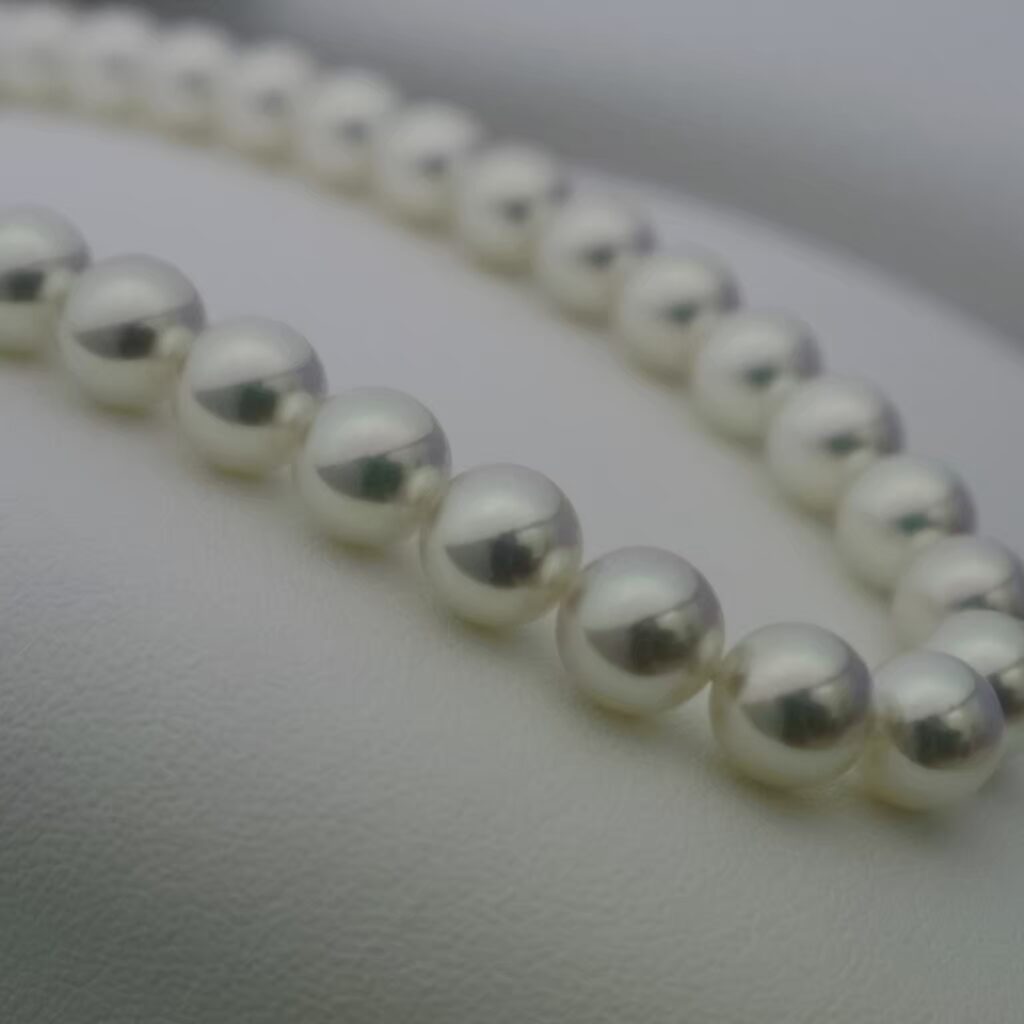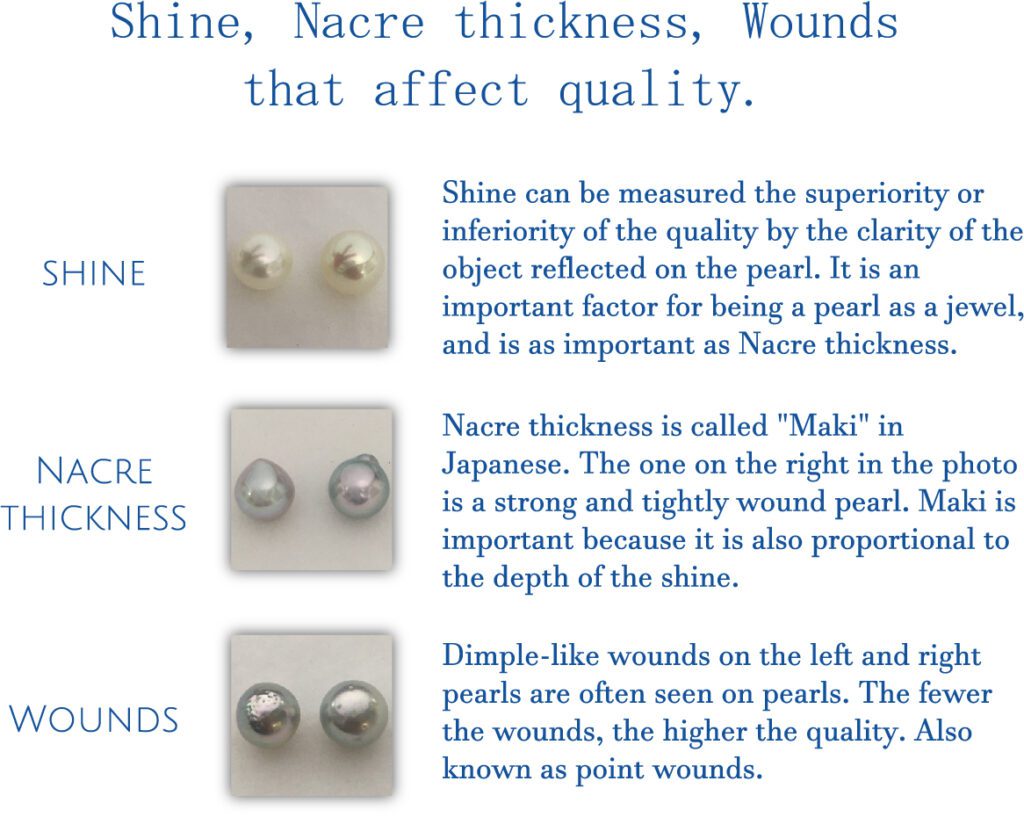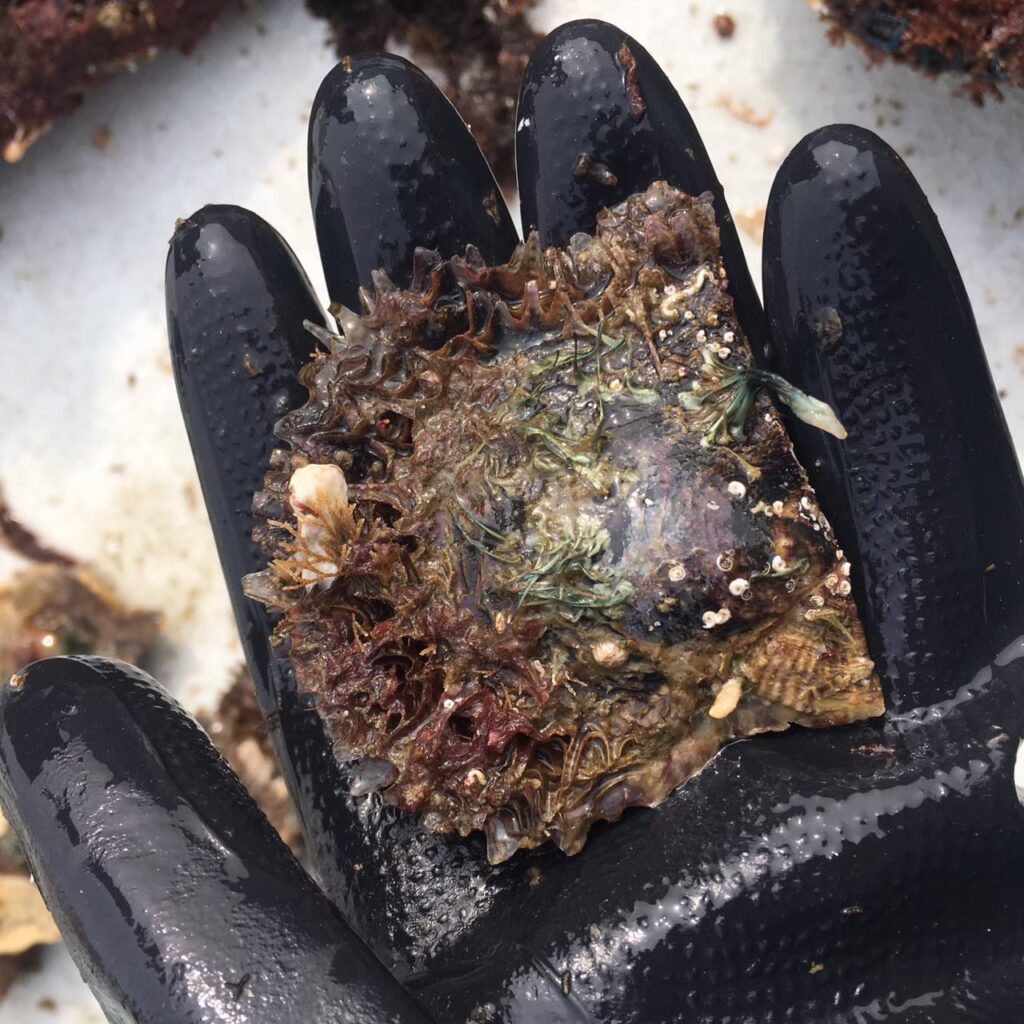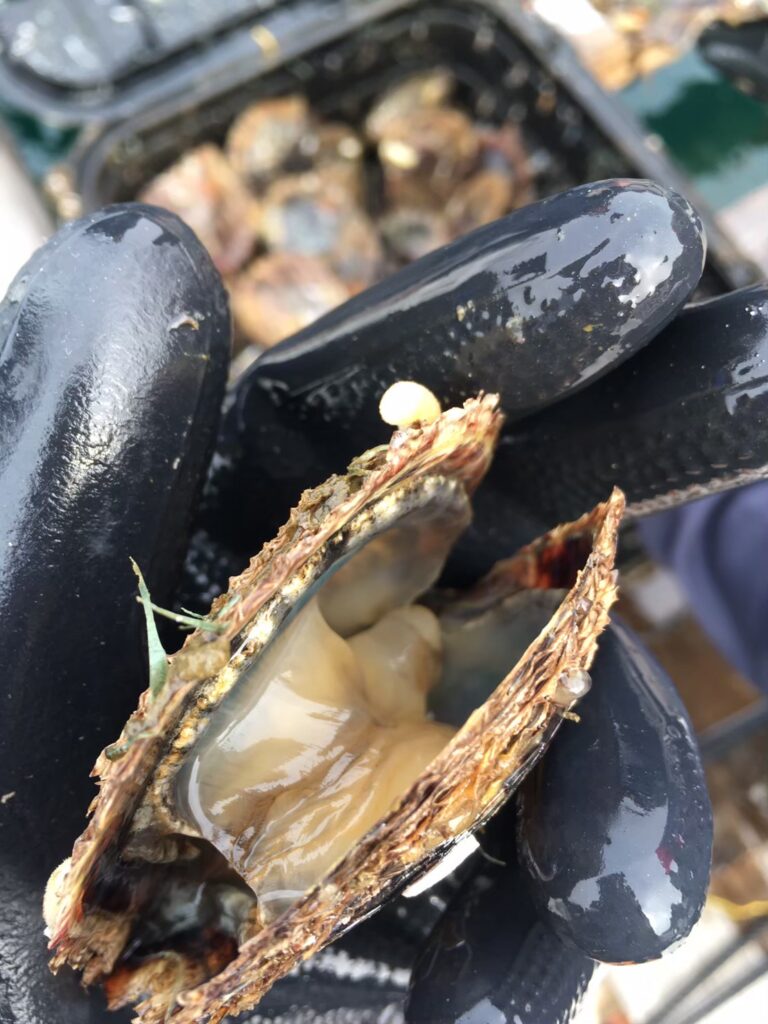“I don’t know what kind of pearl is good.” ”I’m not a pearl professional, so I can’t judge pearls.”
As someone who sells pearls on a daily basis, I hear these words from customers. As a reference for future pearl buyers, I will explain the six elements that make up a pearl’s beauty: Shine, Nacre thickness, Wounds, Color, Shape and Size.

As mentioned above, the beauty of pearls consists of six elements. These six elements are categorized into quality and individual values and preferences. Importantly, each of these six factors is also reflected in the price. Of course, the higher the quality, the higher the price. Also, in terms of shape, the round is more expensive than the baroque. Round pearls are more expensive than baroque, but the quality doesn’t matter. Expensive does not mean low quality. If you like round pearls, the price of pearls you want will be higher, and if you like baroque pearls, the price of pearls you want will be lower than round pearls. These are a bit complicated, but I want everyone to remember.
Pearl beauty: Shine, nacre, wounds
The beauty of pearls has elements that are classified by quality and our taste, each of which affects the price. In choosing a good pearl, we can freely choose the color, shape and size because we like them. However, in choosing good pearls, we need to be careful about Shine, Nacre thickness and Wounds.
Generally, it is said that “round pearls are good”. That said, the choice of low shine, Thin nacre, round pearls remains questionable. Even if you buy round pearls, if the pearls don’t shine, it may be difficult to get excited. Pearls are gems. The brilliance and the Nacre thickness that supports the brilliance are very important when obtaining pearls as jewelry.

Let’s assume our budget is $1000 to purchase a 7.5mm size pearl necklace. We can buy a fine necklace for $2000 at any fair Japanese jewelry store. (Of course, high-end brands such as Mikimoto and Tazaki are more expensive.) When buying a good necklace for $1000, what we want to look for is brilliance and nacre thickness. Shine and nacre thickness are very important to us when choosing pearls, so I repeat them many times.
Choosing a necklace is simple. Pick a few of the brightest ones on sale for $1000. And once we’ve chosen some necklaces with strong shine, it’s time to choose some of the thickest nacre. I think that wounds will surely stand out a little in the necklace chosen in that way. I think that is the correct answer. Among $1000 necklaces, there are basically no necklaces that are round, have few wounds, and have nacre thick. As someone who works for a company that owns Akoya pearl farms, I am involved in the harvesting of pearls, their selection, and even participating in pearl auctions. So, I understand the market prices of primary, secondary and tertiary industries such as pearl farms, wholesalers and retailers. From my point of view, if our budget is $2000, we can buy a necklace that is fine in almost every respect, but if our budget is $1000, we In some respects it comes down to picking a necklace that has to be compromised. The element that needs to be compromised is the wounds. When we look at a pearl, we can tell the difference between Shine and Nacre thickness even from a few meters away. But with wounds, we don’t know if the wounds are there or not if we move a little away from the pearl. If our budget is not capped, pearls without wounds are better. But for most people, budgets are always capped. At my high end, I can’t stand and my high limit is so low that I have to remain seated.

In other words, choosing a necklace with more wounds will reduce the price of the necklace. Among them, choose a necklace with strong Shine and Nacre thickness. For necklaces of the same price, same size, choosing a pearl with fewer wounds will result in a pearl necklace with less brilliance and a thinner nacre layer, and choosing a necklace with more wounds will result in a necklace with a stronger brilliance and a thicker nacre layer. When I choose pearls, I do the same. In recent years, it seems that more and more clerks are giving advice like this at pearl retail stores. However, in most department stores and jewelry stores in Japan, there are not many clerks who give such advice. Many of them have no knowledge about pearls, so they often recommend us pearls that are round in shape and have few wounds. At the same time, Japanese pearl associations regularly provide such retailers with opportunities to advise and educate them on the correct way to view pearls. Retailers from all over Japan participate in the monthly study group and strive to improve their knowledge of pearls. Recently, thanks to Zoom, I think it is very meaningful to be able to participate in study sessions even if they are in a remote location.
Nacre depth adds beauty

The above describes brilliance and nacre thickness and wounds. I think brilliance is easy to understand. A pearl that is as clear as a mirror. Nacre thickness can be difficult to understand. Let me introduce a parable that I often use.
New saran wrap and a few remaining saran wraps
A new saran wrap has many layers of transparent wrap, so you can see the depth when you look at the core. On the other hand, saran wrap, which is likely to empty after a few more uses, has fewer layers of wrap, so when you look at the core, the core looks sharp and lacks depth. The layers of saran wrap and nacer are very similar.
Hot water in bathtub
Imagine the difference in a bathtub when it is low on water and when it is full. In terms of the sea, it is how the sea looks in shallow water and offshore. The deeper the water, the deeper it is. Of course. These are also very similar to the thickness and thinness of nacre. When you look at the deep sea, where you can’t see the bottom, don’t you feel drawn in? I think it might be the charm of the sea.
In nacre, I think the more depth there is, the more attractive it is. I think it resembles something mysterious when we look into the bottomless sea. In pearls, this depth of nacre adds depth to the brilliance of the pearl. I think the brilliance of pearls without depth is beautiful, but the pearls have a thin brilliance. When purchasing such pearls, it may be easier on our wallets to choose imitation pearls. I will speak on the premise that there are parts where the expression is misleading or lacks accuracy. For example, even in humans, I think that mysterious people are attractive. Of course, I think people with easy-to-understand personalities are also good. However, I think that there are many people who we find attractive among people who say, “I don’t know what this person is thinking.” When I look at a pearl with a thick layer of nacre, I sometimes fall into this feeling. When I meet a mysterious person, when I look into the deep sea, when I look at a pearl with nacre thickness, when I look into a washing machine, I think these are very similar. I’m not sure how much I can convey to everyone with these expressions, but I’ll stop here for now. Anyway, I just want to keep saying that brilliance and nacre thickness are very important for pearls.
What is the impact of wounds?
This is the easiest. We know pearls when we see them. Wounds can occur in pearls for a number of reasons. When the condition of Akoya oysters deteriorates, the secretion of nacre becomes abnormal. The layers of pearl are like brick walls. When the condition of the Akoya shellfish deteriorates, the bricks, which had been neatly piled up until then, become irregular. If the layers of pearls are regular and orderly stacked like a brick wall, the light that hits the pearls goes straight to the inside of the pearls. The light reflected by such pearls emits a very beautiful interference color, even from our point of view. However, the interference colors emitted by the pearls, which have layers of pearls like crumbling, irregularly stacked brick walls, are, simply put, vague. If we stack 100 sheets of clear glass, we can still see through to the bottom, but if we stack 10 sheets of dirty glass, we will not be able to see through to the bottom.

When do Akoya shellfish get sick? Akoya shellfish are comfortable at a water temperature of 20 to 25 degrees Celsius. When the water temperature is around 10 degrees, Akoya shellfish hibernate and survive without food. What do you do when the water temperature is high in midsummer? They may just endure the situation. In recent years, thanks to breed improvement, the number of Akoya shellfish that can withstand high water temperatures in midsummer has increased, but I will talk about this next time.

In the future, I would like to write an article about the ecology of Akoya shellfish, when to add the spherical “nucleus” that is the nucleus of the pearl, how many to add per day, and how to prepare for it. In this article, I wrote down things that will be helpful in choosing pearls. However, I will continue to explain from a more multifaceted perspective and with different expressions from this time. I want as many people as possible to know the charm of pearls and how to choose them.
Every day at the Akoya pearl farm, many employees take care of the Akoya shellfishes in an environment that can never be said to be comfortable, whether it is hot or cold. Pearls, like other agricultural, forestry and fishery products, are by no means easy to produce. We will be able to work even harder if we can let as many people know about them as possible.


Comment